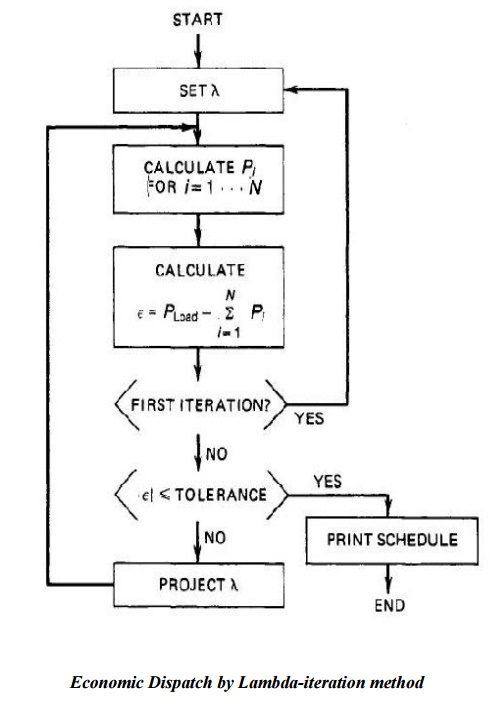Chapter: Power System Operation and Control : Commitment and Economic Dispatch
Economic Dispatch Solution By Lambda-Iteration Method
ECONOMIC DISPATCH SOLUTION BY
LAMBDA-ITERATION METHOD
Ø Block diagram of the lambda-iteration method of
solution for the all-thermal, dispatching problem-neglecting losses.
Ø We can approach the solution to this problem by
considering a graphical technique for solving the problem and then extending
this into the area of computer algorithms.
Ø Suppose we have a three-machine system and wish
to find the optimum economic operating point.
One approach would be to plot the incremental
cost characteristics for each of these three units on the same graph, In order
to establish the operating points of each of these three units such that we
have minimum cost and at the same time satisfy the specified demand, we could use this sketch and a ruler
to find the solution.
Ø That is, we could assume an incremental cost
rate (λ)
and find the power outputs of each of the three units for this value of
incremental cost. the three units for this value of incremental cost.
Ø Of course, our first estimate will be
incorrect.
Ø If we have assumed the value of incremental
cost such that the total power output is too low, we must increase the 3.
value and try another solution.
Ø With two solutions, we can extrapolate (or
interpolate) the two solutions to get closer to the desired value of total
received power.
Ø By keeping track of the total demand versus the
incremental cost, we can rapidly find the desired operating point.
Ø If we wished, we could manufacture a whole
series of tables that would show the total power supplied for different
incremental cost levels and combinations of units.
Ø That is, we will now establish a set of logical
rules that would enable us to accomplish
the same objective as we have just done with
ruler and graph paper.
Ø The actual details of how the power output is
established as a function of the incremental cost rate are of very little
importance.
Ø We could, for example, store tables of data
within the computer and interpolate between the stored power points to find
exact power output for a specified value of incremental cost rate.
Ø Another approach would be to develop an
analytical function for the power output as a function of the incremental cost
rate, store this function (or its coefficients) in the computer, and use this
to establish the output of each of the individual units.
Ø This procedure is an iterative type of
computation, and we must establish stopping rules.
Ø Two general forms of stopping rules seem
appropriate for this application.
Ø The lambda- iteration procedure converges very
rapidly for this particular type of optimization problem.
Ø The actual computational procedure is slightly
more complex than that indicated ,since it is necessary to observe the
operating limits on each of the units during the course of the computation.
Ø The well-known Newton-Raphson method may be used to project the incremental cost value
to drive the error between the computed and desired generation to zero.

Related Topics